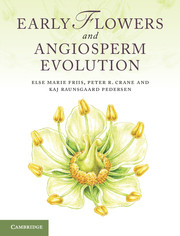Book contents
- Frontmatter
- Contents
- Preface
- 1 Introduction to angiosperms
- 2 The nature of the angiosperm fossil record
- 3 The environmental context of early angiosperm evolution
- 4 Stratigraphic framework and key areas for Cretaceous angiosperms
- 5 Angiosperms in context: extant and fossil seed plants
- 6 Origin and age of angiosperms
- 7 Phylogenetic framework and the assignment of fossils to extant groups
- 8 Fossils near the base of the angiosperm tree
- 9 Early fossil angiosperms of uncertain relationships
- 10 Early fossils of eumagnoliids
- 11 Fossils of monocots
- 12 Fossils of eudicots: early-diverging groups
- 13 Fossils of core eudicots: basal lineages
- 14 Fossils of core eudicots: rosids
- 15 Early fossils of eudicots: asterids
- 16 Patterns of structural diversification in angiosperm reproductive organs
- 17 History and evolution of pollination in angiosperms
- 18 History and evolution of dispersal in angiosperms
- 19 Vegetational context of early angiosperm diversification
- 20 The accumulation of angiosperm diversity
- References
- Index
4 - Stratigraphic framework and key areas for Cretaceous angiosperms
Published online by Cambridge University Press: 07 September 2011
- Frontmatter
- Contents
- Preface
- 1 Introduction to angiosperms
- 2 The nature of the angiosperm fossil record
- 3 The environmental context of early angiosperm evolution
- 4 Stratigraphic framework and key areas for Cretaceous angiosperms
- 5 Angiosperms in context: extant and fossil seed plants
- 6 Origin and age of angiosperms
- 7 Phylogenetic framework and the assignment of fossils to extant groups
- 8 Fossils near the base of the angiosperm tree
- 9 Early fossil angiosperms of uncertain relationships
- 10 Early fossils of eumagnoliids
- 11 Fossils of monocots
- 12 Fossils of eudicots: early-diverging groups
- 13 Fossils of core eudicots: basal lineages
- 14 Fossils of core eudicots: rosids
- 15 Early fossils of eudicots: asterids
- 16 Patterns of structural diversification in angiosperm reproductive organs
- 17 History and evolution of pollination in angiosperms
- 18 History and evolution of dispersal in angiosperms
- 19 Vegetational context of early angiosperm diversification
- 20 The accumulation of angiosperm diversity
- References
- Index
Summary
In this chapter we review the geology and stratigraphic setting of selected localities and areas that are of special importance for research on early angiosperm fossils. We also provide a stratigraphic overview and discussion of the possible age of the major angiosperm floras discussed in this book. Among the key areas considered are the Estremadura and Beira Litoral regions of Portugal, southern Sweden, and eastern North America, where most of our own work has been concentrated, but we also include other areas that have yielded important fossil material, much of which is considered later in this book.
The stratigraphic framework
Establishing a well-corroborated and detailed stratigraphic framework to assess the timing and pattern of angiosperm diversification is not a straightforward task. With few exceptions, angiosperms are land plants and most diverse assemblages of fossil angiosperm leaves and reproductive structures occur in terrestrial sediments deposited close to where the plants grew. Dispersed angiosperm organs, especially pollen, may be transported by wind or water into marine deposits, but the terrestrial input into marine sediments generally decreases with increasing distance from the land. The quality of preservation of palynomorphs and other plant parts in fully marine sediments is also generally poorer than in terrestrial sediments. As a result, although angiosperm fossils do occur in marine deposits, they are more abundant, and usually better preserved, in terrestrial sediments.
- Type
- Chapter
- Information
- Early Flowers and Angiosperm Evolution , pp. 55 - 100Publisher: Cambridge University PressPrint publication year: 2011

